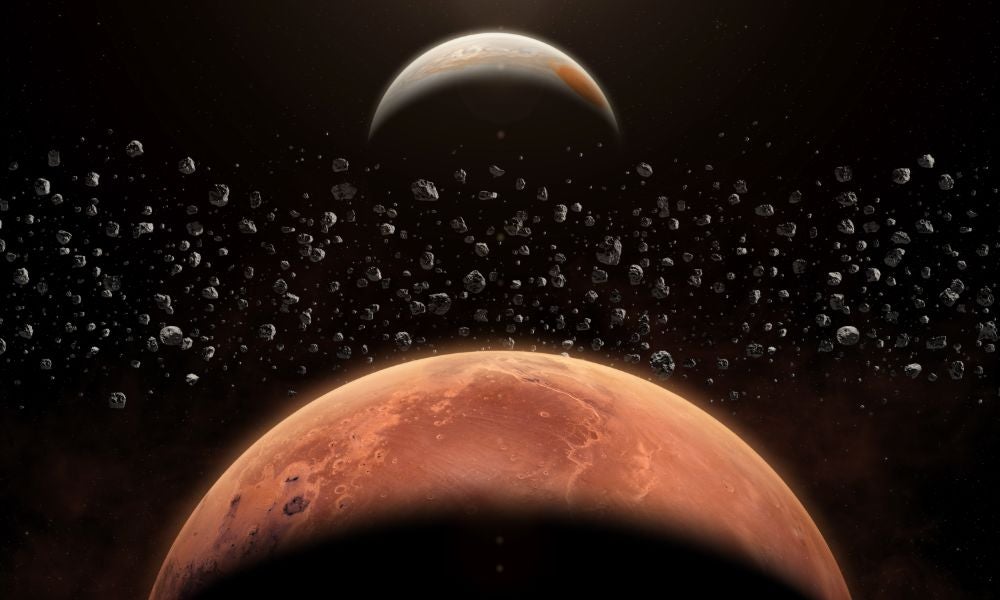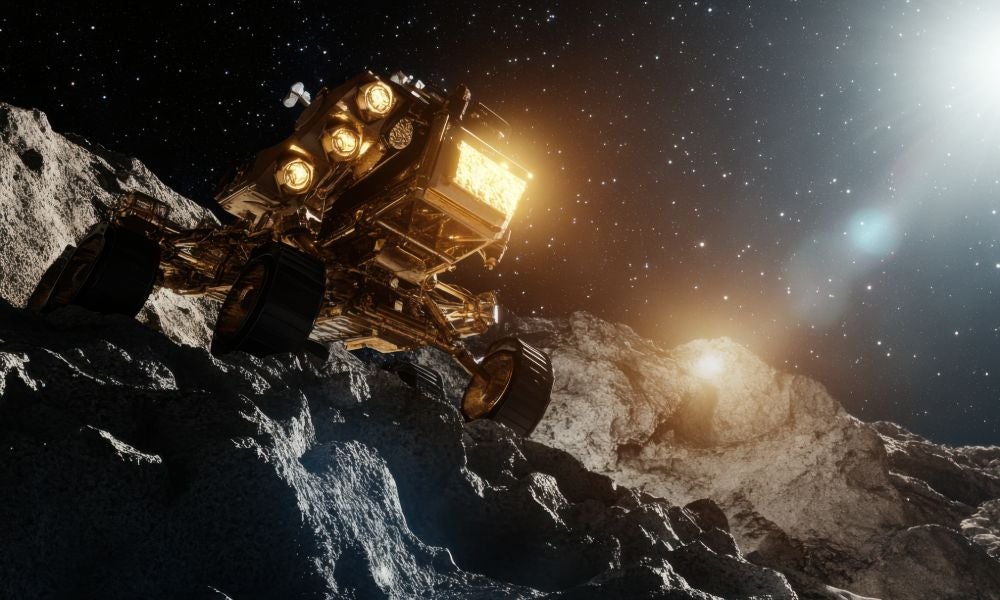The final investment frontier: The economics of space resources
Research examines how a space resources fund could make commercial lunar and asteroid mining a reality, paving the way for a sustainable, global space economy
As humanity pushes further into the cosmos, a new economic frontier is emerging – one that revolves around extracting and utilising valuable materials from celestial bodies. Imagine mining operations not in remote Australian outback locations but on the Moon’s permanently shadowed craters for water ice that could be converted to rocket fuel, or on asteroids rich with rare metals worth trillions of dollars. For forward-thinking business leaders and investors, these aren’t just fascinating scientific possibilities but potential market opportunities that could reshape global supply chains and create entirely new industries over the coming decades.
The space industry, currently valued at around US$500 billion, is projected to grow into a multi-trillion-dollar industry by 2050. While this growth will largely come from traditional space activities like communications and Earth observation, a significant portion could emerge from the extraction and use of space resources. Water extracted from lunar ice could dramatically reduce the cost of deep space missions. Metals mined from near-Earth asteroids could solve critical supply shortages in renewable energy technologies. And resources processed in space could enable manufacturing beyond Earth’s gravity well, opening possibilities for products that simply can’t be made under terrestrial conditions.
While it might sound like science fiction, researchers at UNSW Sydney have demonstrated that the commercial utilisation of space resources may not only be feasible but also potentially lucrative, provided we overcome significant investment, regulatory and governance hurdles. The question isn’t just whether we can access these vast resources, but how we structure the business and legal frameworks to make such ventures both profitable and beneficial for humanity as a whole.
The space resources fund: Balancing benefits and investment
“The prospect of mining space resources like lunar ice and asteroid metals has shifted from science fiction to a feasible frontier. With governments and private entities ramping up efforts, the focus is no longer just on how but also who benefits,” said UNSW Business School Associate Professor Jeff Coulton, who co-authored The space resources fund: A solution to the space resources benefit sharing dilemma? together with UNSW Engineering PhD student Ben McKeown and UNSW Engineering academics Professor Andrew Dempster and Professor Serkan Saydam.

“Space resources are not just a curiosity; they are essential for the future of human activity beyond Earth,” A/Prof. Coulton explained. “Lunar ice can provide water for life support and be converted into rocket fuel, dramatically reducing the cost of deep-space exploration. Asteroids are rich in metals like platinum and cobalt, crucial for both technology and clean energy. However, tapping these resources requires overcoming technical, financial and governance challenges.”
Mr McKeown is a research student at UNSW’s Australian Centre for Space Engineering Research and also serves as Chairman at Tinka Resources, a Canadian-based exploration and development company. Mr McKeown’s current research examines innovative solutions to two critical challenges: how to attract investment in space resources and how to ensure equitable benefit-sharing globally. In a range of recent research papers, Mr McKeown and his UNSW Sydney PhD supervisors argue for mechanisms that balance commercial viability with the ethical imperative of shared benefits.
One of the most pressing issues in the commercialisation of space resources relates to benefit sharing – specifically, how the financial benefits from space resource extraction should be distributed to comply with international treaties that emphasise space should benefit “all humankind”.
"I invested in and managed natural resource projects around the world for many years and have seen how difficult it is to gain the social licence and address all the factors required to develop and commercialise natural resource projects terrestrially,” said Mr McKeown.

“I also grew up in Eswatini, a small African country, representative of those countries unlikely to directly participate in the development of space resources, should it occur. My motivation in this research is to try to combine these perspectives to identify ways to facilitate the commercialisation of space resource utilisation, but at the same time, to try and find ways that those parts of humanity that will not be able to participate directly will be able to benefit indirectly.”
Mr McKeown’s research proposes an innovative solution to this dilemma: the space resources fund. His research analyses how such a fund could facilitate monetary benefit sharing while simultaneously providing investment capital to a nascent space resources industry. According to the research, the space resources fund would have “the double bottom line of both generating monetary benefits from commercial space resource utilisation and providing investment capital to an industry targeting space resource utilisation.” This dual-purpose approach contrasts with traditional royalty mechanisms that could potentially stifle an emerging industry.
Setting realistic investment expectations
The commercial challenges of mining space resources go beyond the technical hurdles of extraction. Similar research investigated the practical financial constraints that could affect the viability of lunar mining operations. In the paper, What is an appropriate investment hurdle rate for commercial space resource development projects?, Mr McKeown and his co-authors (Professors Dempster and Saydam and A/Prof. Coulton) found that hurdle rates in the range of 25% could be appropriate for potential commercial space resource development projects, depending on the perceived risk of the project, and assuming a suitable legal/regulatory regime is in place.

Despite the high return requirements, the research emphasises the extraordinary potential value of these resources. The researchers found that “the valuation of these resources is enormous, with estimates of the gross in situ value of resources (at current metals prices) contained within the asteroid belt between Mars and Jupiter being of the order of US$700 quintillion (million trillion).” This astronomical valuation underscores why companies and investors continue pursuing space resource development despite the substantial challenges and high return requirements.
Exploring the economic realities of space mining
In Commercial Lunar Ice Mining: Is There a Role for Royalties?, Mr McKeown and his co-authors constructed a financial model based on a conceptual lunar thermal ice mining project. Their analysis suggested that royalties (in particular ad valorem royalties) could have a meaningful impact on the economics and operational parameters of a commercial lunar ice mining project, and in turn, potentially impact the ability to raise the funding required to develop such projects.
They determined that a lunar ice mining project with a corporate income tax rate of 15% could tolerate an ad valorem royalty of only about 2% before falling below minimum acceptable investment metrics. At higher rates, project economics deteriorated substantially, with operational impacts extending to resource utilisation decisions. The study showed that a lunar mining project could tolerate an effective tax rate of approximately 20-25%, significantly lower than the 40-60% range typical in terrestrial mining.
“Royalties, particularly ad valorem royalties, could have a meaningful impact on the economics and operational parameters of a commercial lunar ice mining project, in turn potentially impacting the ability to raise the funding required to develop such projects,” the researchers noted in their paper, published in Space Policy.
Subscribe to BusinessThink for the latest research, analysis and insights from UNSW Business School
The researchers also found that global monetary benefits from such royalties could be minimal. Their calculations showed that even with substantial industry growth at 6% annually, the per capita benefits would be “negligible” – amounting to under $7 per person in low-income countries in aggregate over 50 years. This economic reality needs careful consideration as the international community develops frameworks for space resource utilisation.
Perhaps as critically, the research demonstrated that geological factors would play a crucial role in the economics of lunar mining. The study found that for deposits with low resource homogeneity, a 2% royalty could reduce economically recoverable resources by 25% and decrease net present value by 30%. For deposits with high homogeneity, the impact was less severe but still significant, with a 6% reduction in recoverable resources at the same royalty rate.
Instead of traditional royalties, The space resources fund: A solution to the space resources benefit sharing dilemma? proposed the space resources fund as an alternative benefit-sharing mechanism. This approach would serve dual objectives: providing investment capital for the emerging space resources industry while facilitating monetary benefit sharing. Such a fund could better balance the need for commercial viability with the ethical imperative of shared benefits from space resources, potentially serving as a practical solution to the space resources benefit-sharing dilemma. It could also provide a mechanism through which global collaboration could be achieved to address the issues more broadly relating to possible commercial space resource utilisation.

Commercial lunar mining: The safety zone dilemma
Mr McKeown and his co-authors have also examined the practical challenges facing large-scale lunar mining operations, particularly regarding the governance frameworks needed to manage extensive surface activities. Their study, Artemis Accords: Are Safety Zones Practical for Long-Term Commercial Lunar Resource Utilisation, examined whether the safety zones proposed in the Artemis Accords offer a workable solution for commercial lunar resource extraction.
It found that the potential scale of commercial lunar mining operations could create unprecedented governance challenges. Their analysis projected that water extraction from lunar permanently shadowed regions to meet future demand could require operational areas between 64 km² and 1556 km², depending on the market scenarios.
“Commercial lunar resource extraction activities could become a reality in the mid- to long-term. Under the existing Outer Space Treaty, there is ambiguity regarding the legal context within which such activities could occur,” said the researchers, who determined that safety zones, while proposed as temporary areas to prevent harmful interference with lunar activities, face practical limitations when applied to commercial operations. Their analysis showed that if multiple companies competed for valuable lunar ice deposits, safety zones surrounding operations could sterilise significant resource areas and create complex operational boundaries.

The study compared potential lunar mining with terrestrial operations, noting that the Carajas Iron Ore mine in Brazil – one of Earth’s largest surface mining operations – covers approximately 125 km² and operates under comprehensive legal frameworks that do not yet exist for space. The researchers concluded that while safety zones might work for small-scale exploratory missions, they are impractical for governing large-scale commercial lunar resource production without additional multilateral agreements.
“This is a key point, as without legal certainty regarding long-term exclusive access to a resource, mining companies, whether terrestrially or in space, are unlikely to undertake a resource development, or be able to raise the substantial funds required to do so,” said Mr McKeown.
Building for the long-term
What emerges from this body of research is a vision of space resource utilisation that balances commercial viability with equitable benefit sharing. By learning from terrestrial models while acknowledging the unique challenges of space, A/Prof. Coulton said we may be able to avoid repeating past mistakes.
Learn more: Contract labour mining safety: hidden costs and business risks
“As commercial lunar and asteroid mining inches closer to reality, frameworks like the space resources fund could offer a pathway to equitable and sustainable industry growth. International collaboration will be key. Initiatives like the Artemis Accords, which promote cooperative lunar exploration, are a promising start but must address broader benefit-sharing mechanisms,” said A/Prof. Coulton, who underscored the importance of Mr McKeown’s research and how the decisions that are made today about governance, investment structures and benefit sharing will shape humanity’s relationship with space resources for generations to come.
“UNSW Sydney’s research highlights that this is not just about mining celestial bodies but about forging a future where space benefits everyone. With the right policies, we can avoid the mistakes of past resource booms on Earth and build a more inclusive extraterrestrial economy,” he concluded.
